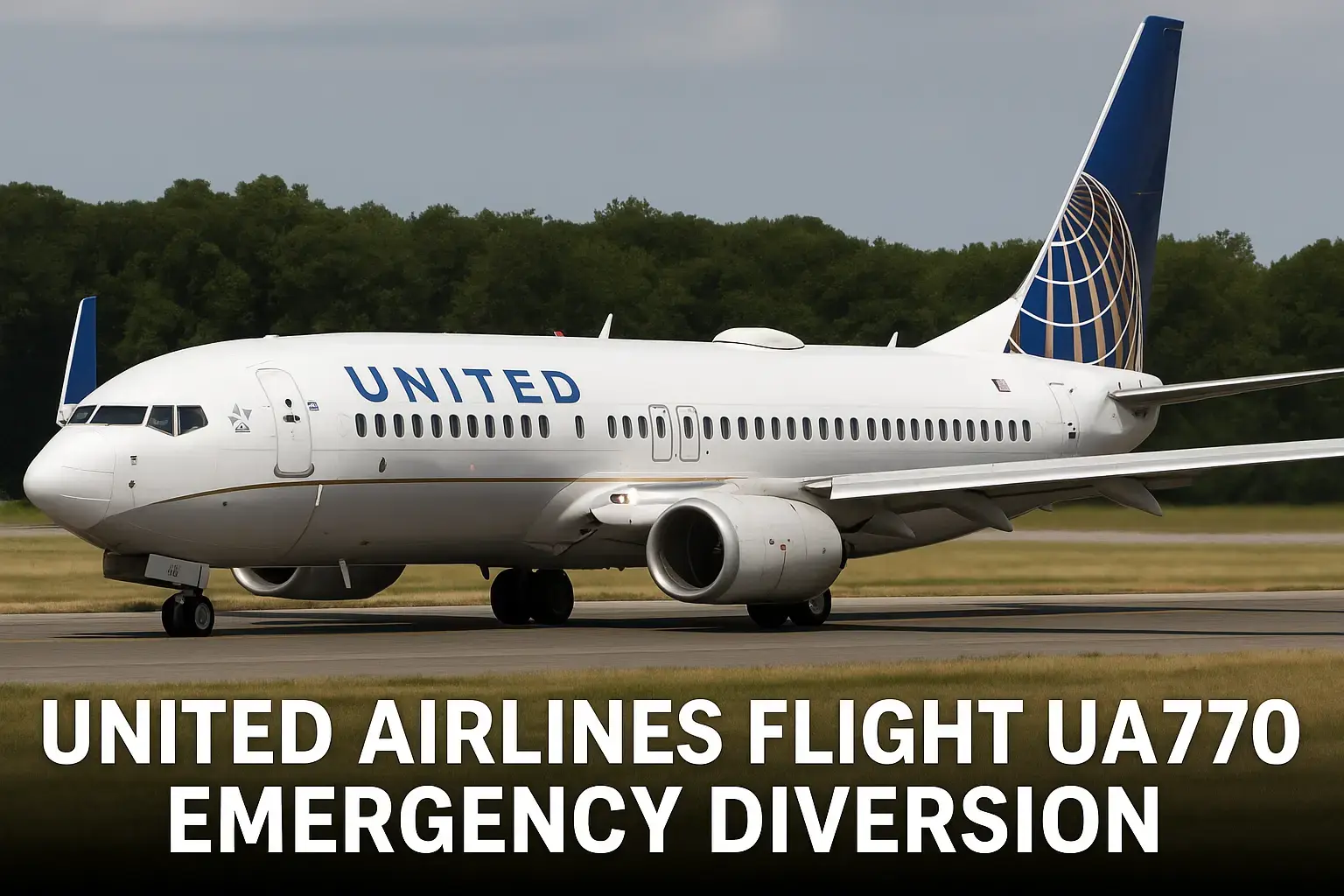On July 24, 2025, United Airlines Flight UA770, en route from Miami to Chicago, made an emergency diversion due to a pressurization failure mid-air. The Boeing 737-800 aircraft descended rapidly and landed safely in Nashville International Airport. No injuries were reported, but the incident triggered a FAA investigation, grounded the aircraft for inspection, and raised critical questions about cabin systems and aviation response protocols.
What began as a typical morning departure for United Airlines Flight UA770 ended with oxygen masks deployed, rapid descent, and shaken passengers making an unexpected landing in Nashville. The united airlines flight ua770 emergency diversion has since gained national attention, with viral social media posts, growing scrutiny from regulators, and renewed interest in the inner workings of aircraft safety systems.
In this deep-dive analysis, we unpack every detail: the timeline, the technical failure, passenger reactions, airline response, and what this means for the future of air travel safety.
Table of Contents
ToggleWhat Happened During the United Airlines Flight UA770 Emergency Diversion?
At approximately 9:48 AM EST, United Airlines Flight UA770, a Boeing 737-800, en route from Miami International Airport (MIA) to Chicago O’Hare International Airport (ORD), experienced a sudden loss of cabin pressure while cruising at 35,000 feet over Kentucky airspace.
Within minutes, the crew initiated an emergency descent and diverted to Nashville International Airport (BNA), where the aircraft landed safely with 162 passengers and 6 crew members on board.
Full Flight Details
| Flight Detail | Information |
| Flight Number | UA770 |
| Route | Miami (MIA) → Chicago O’Hare (ORD) |
| Date | July 24, 2025 |
| Aircraft Type | Boeing 737-800 |
| Tail Number | N76521 |
| Passengers | 162 |
| Crew | 6 (2 pilots, 4 cabin crew) |
| Diversion Airport | Nashville International Airport (BNA) |
| Incident Type | Pressurization failure / Emergency diversion |
Timeline of Events: From Takeoff to Emergency Landing
7:10 AM EST – UA770 departs from Miami International Airport (MIA) on schedule.
8:35 AM – Aircraft reaches cruising altitude of 35,000 feet over eastern Kentucky.
8:47 AM – Pilots detect anomalies in cabin pressure. Oxygen masks deploy automatically.
8:48 AM – Captain declares an emergency with Air Traffic Control (ATC) and begins rapid descent to 10,000 feet.
9:05 AM – Aircraft diverted to nearest suitable airport: Nashville International (BNA).
9:22 AM – UA770 lands safely. Emergency services on standby but not needed.
9:40 AM – Passengers deboard; medical staff performs precautionary evaluations.
Technical Breakdown: Cabin Pressurization Systems and How Failures Occur
How Pressurization Works in a Boeing 737-800
Commercial aircraft cabins are pressurized to maintain breathable oxygen levels at high altitudes. The Boeing 737-800 uses an air cycle machine (ACM) and outflow valve system to control pressure.
- Air drawn from engines is cooled and regulated
- Cabin pressure is maintained at ~8,000 feet equivalent at cruising altitudes
- Outflow valves release air to prevent over-pressurization
What Caused the Pressurization Failure on UA770?
While a full investigation is ongoing, preliminary reports indicate a malfunction in the outflow valve control system, potentially due to a faulty sensor or software anomaly. This led to:
- Cabin altitude exceeding safe limits
- Automatic deployment of oxygen masks
- Crew initiating emergency descent to restore breathable air pressure
Immediate Airline Response and Passenger Assistance
United Airlines issued a public statement within two hours:
“Safety is our top priority. Flight UA770 diverted to Nashville due to a pressurization issue. The flight landed safely, and we are providing support to all passengers.”
Actions Taken by United:
- Hotel accommodation for all affected passengers
- Rebooking assistance for continuation to Chicago
- Medical evaluations offered voluntarily
- Refund and travel credit for inconvenience
Passenger Experiences and Eyewitness Accounts
Many passengers shared their harrowing experience on social media, with videos of deployed oxygen masks gaining rapid traction.
“The plane just dipped. Alarms were going off. It was terrifying,” said Samantha Lee, a passenger en route to visit family in Chicago.
“The crew stayed calm, but you could hear people praying,” added Carlos Mendes, another traveler.
Despite the fear, crew professionalism was widely praised.
“They walked us through every step, kept us informed, and stayed calm. They were heroes,” said a flight attendant’s niece, tweeting from the airport.
FAA and NTSB Investigation Details and Implications
Both the Federal Aviation Administration (FAA) and the National Transportation Safety Board (NTSB) opened a joint inquiry into the UA770 diversion today.
Investigation Focus Areas:
- Data from flight data recorders (FDR)
- Cabin pressure control system diagnostics
- Maintenance logs and repair history
- Pilot decision-making and response protocols
While the final report may take months, early indicators suggest mechanical failure rather than pilot error.
Current Status of the Aircraft and Ongoing Maintenance
The aircraft involved in the united airlines flight ua770 emergency diversion has been removed from service and is undergoing full diagnostics at a United Airlines maintenance facility in Houston.
Maintenance Steps:
- System-wide cabin pressurization inspection
- Outflow valve and sensor testing
- Software and control module review
- FAA clearance before returning to service
As of now, the aircraft is grounded pending FAA review.
How Rare Are Such Diversions? (With Global Statistics)
Emergency diversions due to pressurization issues are rare but not unprecedented.
Industry-Wide Statistics (Based on FAA and IATA Data):
- 3–4 incidents per million flights involve cabin pressurization issues
- Emergency diversions account for 0.04% of all flights globally
- Boeing 737-800 models have a high safety record despite occasional events
Comparison:
| Airline Incident | Year | Aircraft | Outcome |
| United UA770 (this event) | 2025 | Boeing 737-800 | Safe landing |
| Southwest Flight 1380 (engine failure) | 2018 | Boeing 737-700 | 1 fatality |
| American Airlines Flight 1384 | 2022 | Boeing 737-800 | Safe emergency descent |
United Airlines’ Safety Record and Handling of Previous Diversions
United Airlines has a strong safety track record, with comprehensive crew training, fleet maintenance, and incident response protocols.
Past Notable Diversions:
- UA328 (2021) – Engine failure post-takeoff, safe return to Denver
- UA145 (2023) – Medical emergency onboard, diverted to Dallas
In all cases, United received commendations for swift pilot action and transparent communication.
Lessons for Passengers and Industry Best Practices
For Passengers:
- Know how to use oxygen masks
- Listen carefully to safety briefings
- Stay calm and follow crew instructions
For the Industry:
- Enhanced cabin system diagnostics
- Redundant sensor pathways
- Real-time data streaming to ground crews
The united airlines flight ua770 emergency diversion underscores the need for proactive maintenance and ongoing crew training.
FAQ: Frequently Asked Questions
What triggered the UA770 diversion today?
A cabin pressurization failure triggered automatic emergency procedures.
Was anyone injured in the incident?
No injuries were reported among passengers or crew.
What kind of aircraft was involved?
A Boeing 737-800, a widely used and typically reliable aircraft.
How did passengers react?
Reports describe fear and anxiety, but also praise for the crew’s composure.




















!["Screenshot of [tipbet88.site] homepage showing betting options and promotions.](https://www.digitalfarooq.com/wp-content/uploads/2024/09/unnamed-2.png)